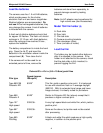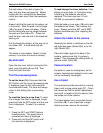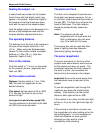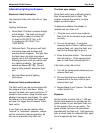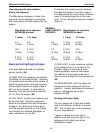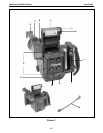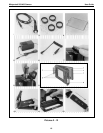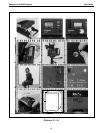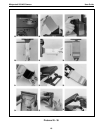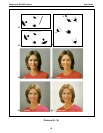
Miniportrait 203/403 Camera User Guide
12
How changing the lamp distance
affects the exposure
The table below indicates in f-stops how
exposure can be adjusted by moving the
main lamp nearer or farther away from the
subject.
ORIGINAL
New distance for exposure LAMP-SUBJECT New distance for exposure
INCREASE of about DISTANCE INCREASE of about
1 f-stop 1/2 f-stop 1 f-stop 1/2 f-stop
4 ft. 5 ft. 6 ft. 7 1/2 ft. 8 1/2 ft.
(1.30m) (1.50m) (1.80m) (2.20m) (2.60m)
(5 ft. 5 1/2 ft. 7 ft. 8 1/2 ft. 10 ft.
(1.50m) (1.70m) (2.10m) (2.60m) (3.00m)
5 1/2 ft. 6 1/2 ft. 8 ft. 9 1/2 ft. 11 ft.
(1.70m) (2.00m) (2.40m) (2.90m) (3.40m)
To maintain the correct exposure balance
throughout the picture, the other lamps in
the setup should be moved closer or farther
away in the same proportion as the main
lamp. Do not change the camera-to-subject
distance.
Basic portrait lighting technique
Four basic lights are used for complete
portrait lighting (39).
(A) MAIN LIGHT-for pleasing and effective
“modelling” to the subject’s face. Generally,
it is positioned to one side of the camera, at
about the angle shown, and pointing down
at the subject’s head at an angle of about
45
o
from the horizontal. It casts distinct
shadows. This light should be at least 2m
(6-7 ft.) from the subject (40).
(B) FILL LIGHT- to soften the shadows cast
by the main light. This light is generally
aimed at the subject from near the camera
viewpoint. Its distance from the subject
must be adjusted carefully, so that it does
not eliminate the shadows altogether, or
cast a shadow of its own (41).
(C) RIM LIGHT- to give a pleasing highlight
to the subject’s hair, or a rim light to the
shoulder. Ideally, it should be a small
focusing spotlight, aimed at the subject
from behind, and well above. Be sure it
does not shine straight into the camera lens
(42).
(D) BACKGROUND LIGHT-to lighten the
background so the subject will stand out
against it. Usually, identification documents
require a photograph with a light
background (43).
Working with fewer lights
You can replace the fill light with a white
card or foil reflector, as shown in picture
(37). The rim light may not be necessary
for your requirements.
If space is limited, one main light, a
reflector card and a second light for the
background will satisfy most photo-
identification needs.



